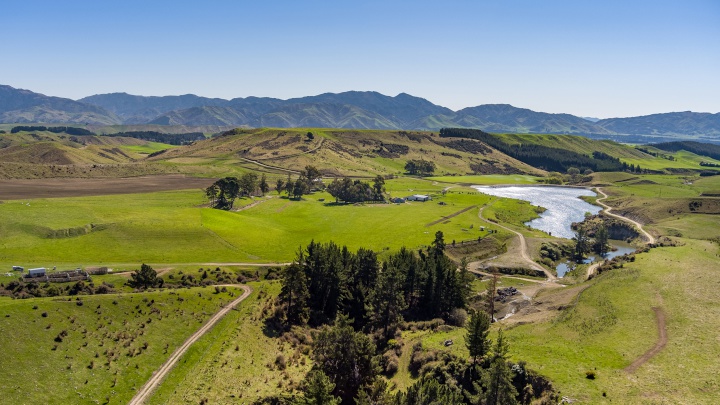Vineyard development block on the market
Vineyard development block and substantial irrigation dam placed on the market for sale.

A 100-hectare block of vineyard development land in New Zealand’s premier grape growing region – sustained by a fully consented 250,000 cubic metre dammed reservoir with enough water to irrigate vines for up to two years – has been placed on the market for sale.
The north facing block in the Awatere Valley region of Marlborough is surrounded by some of the country’s leading wine companies - including such brands as Ballochdale, Awatere Valley, Black Birch, Tupari Wines, Koura Bay, Stanley Estates, Eradus, Vavasour Wines, and Yealands Estate.
The land and dammed reservoir at 496 Haldons Road consists of some 60 hectares of flat topography suitable for sustaining the planting of long flat vines, with the remaining approximately 40 hectares of rolling and undulating land suitable for planting of smaller length vines. The land had previously been used for livestock grazing.
The property is traversed by a network of well-formed gravel roads, with the main building on the property being a former aircraft hangar from a long-gone grassed airfield strip.
The 181.2 hectares of land and dammed reservoir at 496 Haldons Road are now being marketed for sale by tender through Bayleys Marlborough, with the tender process closing on November 4. Salesperson Mike Poff said the property’s most obvious asset was its consented and functioning dam and reservoir.
Mr Poff said that to build a dam of such scale now, would cost in the region of $4.5 million. The dam and reservoir are consented to draw up to 300,000 cubic metres of water annually from the nearby Starborough Creek.
“There are limited landholdings of this scope and topography suitable for vineyard conversion in Awatere Valley, and certainly very few with the asset of their own substantial water supply and major infrastructure asset of this size,” he said.
“Certainty of water supply is an underlying consideration for any potential viticulture operation – and with its consent in place, the dam and reservoir facility at Haldons Road certainly delivers that critical assurance of on-going storage and irrigation.”
Mr Poff said the flat to gently rolling block was located some 235 – 295-metres above sea level, and recorded an annual average rainfall of between 700 – 750mms – with the greenfield undeveloped layout and flat to gently sloping contour making the establishment of vines relatively easy.
“With distinct growing locations dispersed across various quarters of the 100-hectare block, plantings are forecast to offer varied fruit characteristics – allowing for a variance in several wine styles and tastes to be produced from one location, whether that be on one single supply contract, or to multiple wineries seeking specific palate profiles to their grapes,” he said.
A viticulture analysis report on the future growing opportunities of the Haldons Road property notes the terroir would be amply suitable for growing sauvignon blanc, pinot gris, pinot noir, pinot blanc or Riesling varietals.
Mr Poff said harvesting data from other vineyards in the Awatere Valley surrounding the Haldons Road site indicated that between 14 – 16 tonnes of sauvignon blanc could be picked per hectare – underpinned by the Awatere Valley’s distinct taste profile, with its minerality being compared to the Sancerre wine produced in France’s Loire Valley.
He said the Haldon’s Road block provided an opportunity for either a new entrant into the region’s viticulture sector, or for an existing operator to increase their presence in producing New Zealand’s foremost exported wine style.
Awatere Valley is one of three ‘sub-regions’ – along with Wairau Valley and Southern Valley - within what is the wider Marlborough grape-growing and wine-producing district. The Awatere Valley accounts for some 30 percent of the province’s vine plantings and is renowned for its herbaceous tropical fruit flavours with underlying crisp acidity.
Awatere Valley is on Marlborough’s seaward boundary - running parallel with the east coast of the South Island. The first vines were planted in Awatere Valley by Vavasour Wines in the late 1980s – with land conversion and viticulture expansion reaching a peak in the late 1990s as land supply tightened.
The vineyards of the Awatere Valley sit on a variety of hills and river terraces in a rugged, rolling landscape. Generally in the Awatere Valley, wind-blown loam soil sits atop a base of alluvial gravel. These resulting dry free-draining soils produce what is known as ‘stressed’ vines which grow deep root systems in search of water and nutrients.
Fruit
in the valley is generally of a thicker skin to protect from
the prevailing sea breezes from the north and east which
extend the area’s growing season longer than its regional
counterparts.


 Financial Markets Authority: FMA Seeks Clarity From High Court On Use Of Eligible Investor Certificates In Wholesale Investment Sector
Financial Markets Authority: FMA Seeks Clarity From High Court On Use Of Eligible Investor Certificates In Wholesale Investment Sector Scion: Scion’s Novel Internship Model Connects Talent With Industry
Scion: Scion’s Novel Internship Model Connects Talent With Industry Financial Markets Authority: Westpac Admits To Misleading Representations That Resulted In $6.35m In Overcharges
Financial Markets Authority: Westpac Admits To Misleading Representations That Resulted In $6.35m In Overcharges Bill Bennett: Download Weekly - Review Of 2024
Bill Bennett: Download Weekly - Review Of 2024 Bill Bennett: One NZ scores worldwide first as Starlink direct-to-mobile launches
Bill Bennett: One NZ scores worldwide first as Starlink direct-to-mobile launches Hugh Grant: How To Reduce Network Bottlenecks
Hugh Grant: How To Reduce Network Bottlenecks



